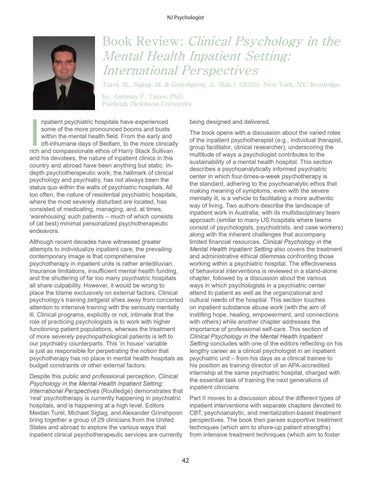NJ Psychologist
Book Review: Clinical Psychology in the Mental Health Inpatient Setting: International Perspectives Turel, M., Siglag, M. & Grinshpoon, A. (Eds.) (2020). New York, NY: Routledge. by, Anthony F. Tasso, PhD Fairleigh Dickinson University
I
npatient psychiatric hospitals have experienced some of the more pronounced booms and busts within the mental health field. From the early and oft-inhumane days of Bedlam, to the more clinically rich and compassionate ethos of Harry Stack Sullivan and his devotees, the nature of inpatient clinics in this country and abroad have been anything but static. Indepth psychotherapeutic work, the hallmark of clinical psychology and psychiatry, has not always been the status quo within the walls of psychiatric hospitals. All too often, the nature of residential psychiatric hospitals, where the most severely disturbed are located, has consisted of medicating, managing, and, at times, ‘warehousing’ such patients – much of which consists of (at best) minimal personalized psychotherapeutic endeavors.
being designed and delivered.
Although recent decades have witnessed greater attempts to individualize inpatient care, the prevailing contemporary image is that comprehensive psychotherapy in inpatient units is rather antediluvian. Insurance limitations, insufficient mental health funding, and the shuttering of far too many psychiatric hospitals all share culpability. However, it would be wrong to place the blame exclusively on external factors. Clinical psychology’s training zeitgeist shies away from concerted attention to intensive training with the seriously mentally ill. Clinical programs, explicitly or not, intimate that the role of practicing psychologists is to work with higher functioning patient populations, whereas the treatment of more severely psychopathological patients is left to our psychiatry counterparts. This ‘in house’ variable is just as responsible for perpetrating the notion that psychotherapy has no place in mental health hospitals as budget constraints or other external factors. Despite this public and professional perception, Clinical Psychology in the Mental Health Inpatient Setting: International Perspectives (Routledge) demonstrates that ‘real’ psychotherapy is currently happening in psychiatric hospitals, and is happening at a high level. Editors Meidan Turel, Michael Siglag, and Alexander Grinshpoon bring together a group of 29 clinicians from the United States and abroad to explore the various ways that inpatient clinical psychotherapeutic services are currently
42
The book opens with a discussion about the varied roles of the inpatient psychotherapist (e.g., individual therapist, group facilitator, clinical researcher), underscoring the multitude of ways a psychologist contributes to the sustainability of a mental health hospital. This section describes a psychoanalytically informed psychiatric center in which four-times-a-week psychotherapy is the standard, adhering to the psychoanalytic ethos that making meaning of symptoms, even with the severe mentally ill, is a vehicle to facilitating a more authentic way of living. Two authors describe the landscape of inpatient work in Australia, with its multidisciplinary team approach (similar to many US hospitals where teams consist of psychologists, psychiatrists, and case workers) along with the inherent challenges that accompany limited financial resources. Clinical Psychology in the Mental Health Inpatient Setting also covers the treatment and administrative ethical dilemmas confronting those working within a psychiatric hospital. The effectiveness of behavioral interventions is reviewed in a stand-alone chapter, followed by a discussion about the various ways in which psychologists in a psychiatric center attend to patient as well as the organizational and cultural needs of the hospital. This section touches on inpatient substance abuse work (with the aim of instilling hope, healing, empowerment, and connections with others) while another chapter addresses the importance of professional self-care. This section of Clinical Psychology in the Mental Health Inpatient Setting concludes with one of the editors reflecting on his lengthy career as a clinical psychologist in an inpatient psychiatric unit – from his days as a clinical trainee to his position as training director of an APA-accredited internship at the same psychiatric hospital, charged with the essential task of training the next generations of inpatient clinicians. Part II moves to a discussion about the different types of inpatient interventions with separate chapters devoted to CBT, psychoanalytic, and mentalization-based treatment perspectives. The book then parses supportive treatment techniques (which aim to shore-up patient strengths) from intensive treatment techniques (which aim to foster












